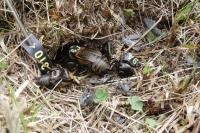The long-standing consensus of why insects stick together after mating has been turned on its head by scientists from the University of Exeter. Published today (6 October) in Current Biology, their study shows that, contrary to previous thinking, females benefit from this arrangement just as much as males.
Instead of dominating their female partners through bullying and aggressive behaviour, males were revealed to be protective, even laying their lives on the line when their mates faced danger.
Previously, scientists assumed that male insects stay close to females after mating to stop them from taking other partners. Female insects have multiple mates and the last mate is most likely to fertilise her eggs. Therefore, by preventing females from taking other mates a male is most likely to father her offspring.
To gain insight into the lives of wild field crickets, the research team used digital video technology, tagging and DNA fingerprinting. They analysed over 200,000 hours of infra-red video footage, taken over two entire breeding seasons, to get a detailed picture of the daily dramas that occur in the insect world.
The researchers found no evidence of males being aggressive towards their mates or hindering a female's movements to or from their burrow. They also discovered that a male will risk his own life to protect a female by allowing her to scamper into their burrow before him when escaping from predators such as birds.
Dr Rolando Rodríguez-Muñozof the 
This image shows a female field cricket at the entrance of her burrow with the remains of her former partner after he was predated. University of Exeter said: "Relationships between crickets are rather different from what we'd all assumed. Rather than being bullied by their mates, it seems that females are in fact being protected. We could even describe males as 'chivalrous'.
"Males and females on their own have similar predation rates, but when they are in pairs, males are killed much more frequently and females always survive to predator attacks.
"It's not completely altruistic though – males are still benefiting. Even if a male is killed, the surviving female is carrying his sperm and ensuring that his DNA lives on."
The team used 96 cameras and microphones to monitor a population of Gryllus campestris crickets in Northern Spain over three entire springs. Super-glued to the back of every cricket was a tiny numbered placard, just big enough for the camera to read. Additionally, a tiny piece of leg tissue less than one millimeter across was used to create a DNA fingerprint of each individual. The visible tags allowed the researchers to analyse their lives and behaviour, including mating partners, how long particular males and females spent together, the time that each male spent singing to attract females and the fights that occur when a male approaches a burrow occupied by another male.
Professor Tom Tregenza of the University of Exeter said: "Males were protective of their partners, but very aggressive with potential competitors. Males cohabiting with a female won more fights against approaching rival males than when they were on their own.
"The footage we filmed and spent months analysing has given us a rare glimpse into how natural selection really happens in the wild. Although our study focused on one population, it is likely that our findings are applicable to other species across the insect world and could even have relevance for other animals. Perhaps females aren't getting pushed around quite as much as we thought they were."
Source : University of Exeter
 Print Article
Print Article Mail to a Friend
Mail to a Friend
